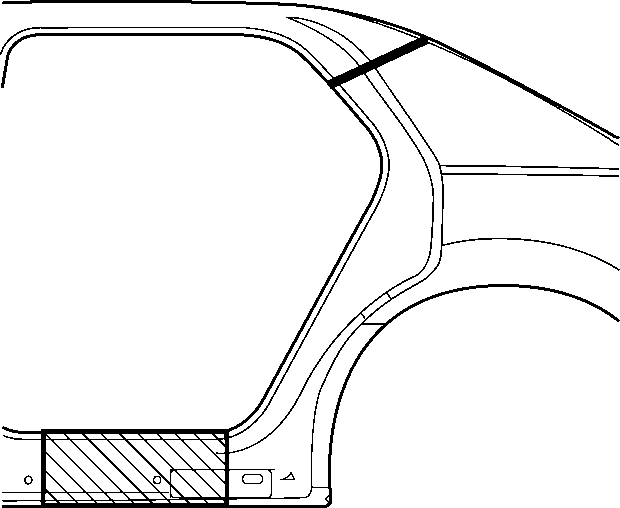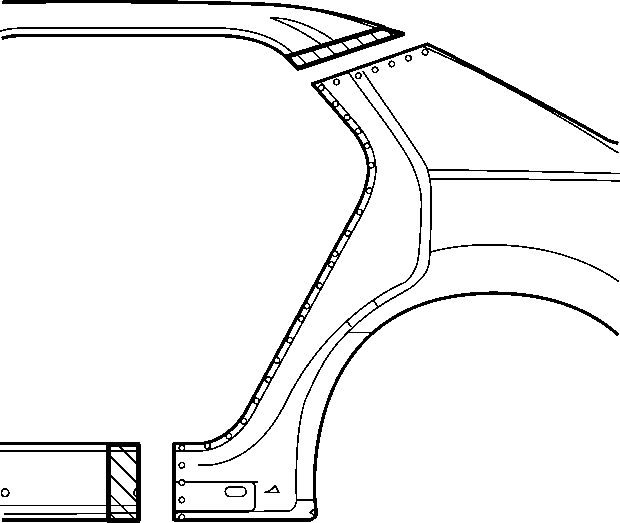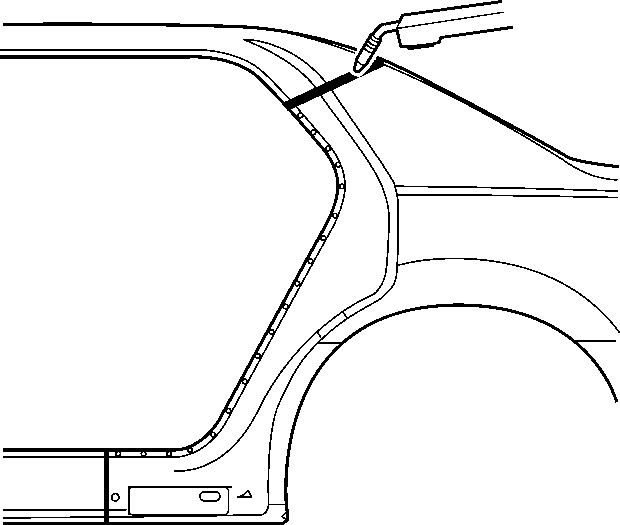Note: The service part comes with lower quarter panel extension attached. These parts can be left on the vehicle of not damaged. Drill out factory welds on the car and service part and use the outer panel only.
Removal Procedure
Warning: Refer to Approved Equipment for Collision Repair Warning in the Preface section.
- Disconnect the negative battery cable. Refer to Battery Negative Cable Disconnection and Connection.
- Disable the SIR system. Refer to SIR Disabling and Enabling.
- Restore as much of the damage as possible to factory specifications. Refer to Dimensions - Body.
- Remove all related panels and components.
- Note the location and remove the sealers and anti-corrosion materials from the repair area, as necessary. Refer to Anti-Corrosion Treatment and Repair.
- Note the location of the structural adhesives.
- Determine sectioning locations in rocker area.
- Mark a line and cut in approved sectioning areas of rocker.
- In upper quarter panel door opening, locate the third weatherstrip hole (1).
- Measure down 25 mm (1 in) and mark a line.
- On back-glass opening, locate rear edge of roof panel.
- Measure down 25 mm (1 in) and scribe a second line. Connect marks at both locations to create a cut line.
- Cut the panel at the marked locations.
- Locate, mark and drill out all factory welds. Note the number and location of welds for installation of the service assembly.
- Remove damaged panel. Note placement and number of foam baffles for new installation. If baffles are damaged, replacement service parts are available.

Note: Do not damage any other panel or reinforcements when cutting at the marked locations.

Installation Procedure
Note: To allow proper layout and cutting of the service part, review the sectioning information in the removal procedure.
- Locate the area on the service part where the sectioning will be performed.
- Measure and mark the cut line location on the service area.
- Cut the service panel at the marked locations. Trim the sectioning butt joints to allow a gap equal to the metal thickness at the sectioning joint.
- Create backing plates 50 mm (2 in) for the sail panel and 100 mm (4 in) for the rocker panel. Create the backing plates from the unused portion of the service part.
- Trim the backing plates as necessary to fit behind the panel at the sectioning joints.
- Drill 8 mm (5/16 in) plug weld holes as necessary in locations noted from the original quarter panel.
- Prepare all mating surfaces as necessary.
- Apply GM-approved Weld-Thru Coating or equivalent to all mating surfaces. Refer to Anti-Corrosion Treatment and Repair.
- Perform the sectioning procedure. Refer to Overlap/Backing Plate Sectioning.
- Install structural adhesive as noted in the Removal Procedure.
- Plug weld accordingly.
- Stitch weld the sail panel and rocker panel accordingly.
- Clean and prepare all welded surfaces.
- Apply the sealers and anti-corrosion materials to the repair area, as necessary. Refer to Anti-Corrosion Treatment and Repair.
- Paint the repair area. Refer to Basecoat/Clearcoat Paint Systems.
- Install all related panels and components.
- Enable the SIR system. Refer to SIR Disabling and Enabling.
- Connect the negative battery cable. Refer to Battery Negative Cable Disconnection and Connection.


Note: If the location of the original plug weld holes can not be determined, or if structural weld-thru adhesive is present, space the plug weld holes every 40 mm (1 ½ in) apart.


Note: Early vehicles have a 45 mm pass thru hole for the wiring harness. Later service parts will have a 58 mm hole. If necessary, cut a 75 mm (3 inch) section out of the original panel and bond it to the new service panel. This will ensure proper sealing of the grommet to the body (1).
